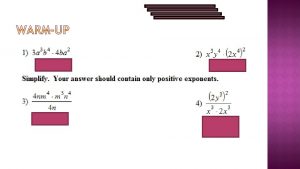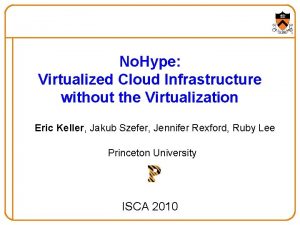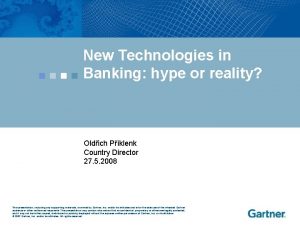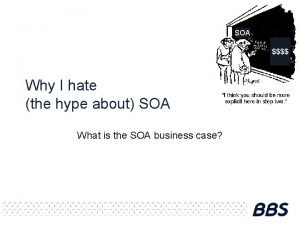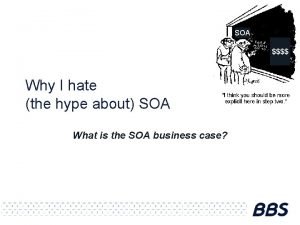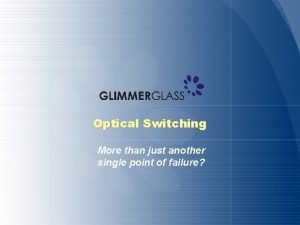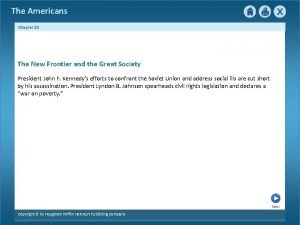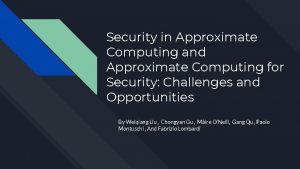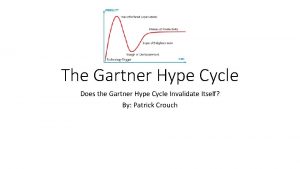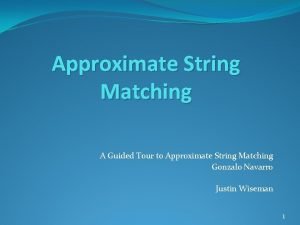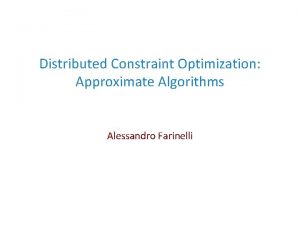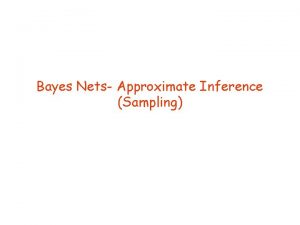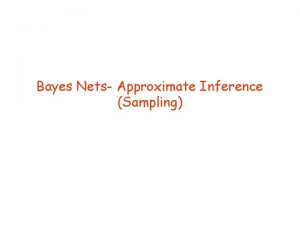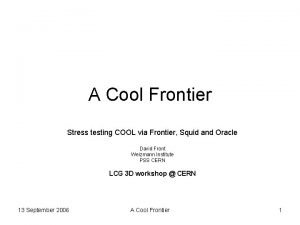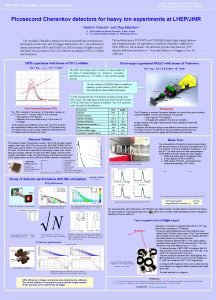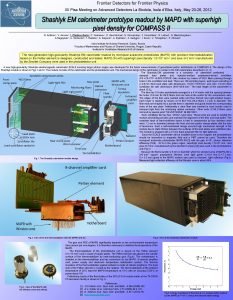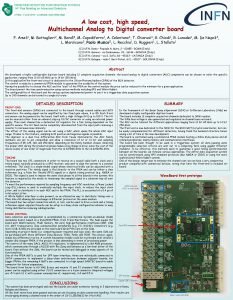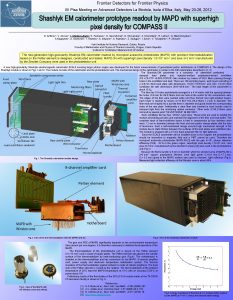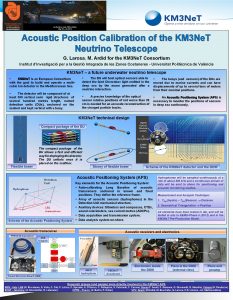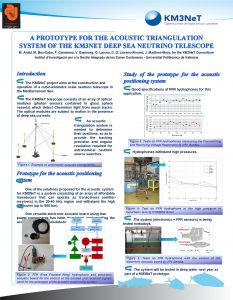Approximate Computing Old Hype or New Frontier Sarita








![SWAT Fault Detection • Simple monitors observe anomalous SW behavior [ASPLOS’ 08, MICRO’ 09] SWAT Fault Detection • Simple monitors observe anomalous SW behavior [ASPLOS’ 08, MICRO’ 09]](https://slidetodoc.com/presentation_image/3dc01d8b41a8c69b6a17016b42c803f0/image-9.jpg)






![Relyzer: Application Resiliency Analyzer [ASPLOS’ 12] Equivalence Classes Pilots Relyzer . APPLICATION. . Output Relyzer: Application Resiliency Analyzer [ASPLOS’ 12] Equivalence Classes Pilots Relyzer . APPLICATION. . Output](https://slidetodoc.com/presentation_image/3dc01d8b41a8c69b6a17016b42c803f0/image-16.jpg)







![SDCs → Detections [DSN’ 12] What to protect? - fault sites SDC-causing Low-cost detectors SDCs → Detections [DSN’ 12] What to protect? - fault sites SDC-causing Low-cost detectors](https://slidetodoc.com/presentation_image/3dc01d8b41a8c69b6a17016b42c803f0/image-24.jpg)












- Slides: 36

Approximate Computing: (Old) Hype or New Frontier? Sarita Adve University of Illinois, EPFL Acks: Vikram Adve, Siva Hari, Man-Lap Li, Abdulrahman Mahmoud, Helia Naemi, Pradeep Ramachandran, Swarup Sahoo, Radha Venkatagiri, Yuanyuan Zhou

What is Approximate Computing? • Trading output quality for resource management? • Exploiting applications’ inherent ability to tolerate errors? Old? GRACE [2000 -05] rsim. cs. illinois. edu/grace SWAT [2006 - ] rsim. cs. illinois. edu/swat Many others Or something new? 2

Overhead (perf. , power, area) Motivation Redundanc y Goal: High reliability at low-cost Reliability 3

SWAT: A Low-Cost Reliability Solution • Need handle only hardware faults that affect software Watch for software anomalies (symptoms) – Zero to low overhead “always-on” monitors Diagnose cause after anomaly detected and recover − May incur high overhead, but invoked infrequently SWAT: Soft. Ware Anomaly Treatment 4

SWAT Framework Components • Detection: Monitor symptoms of software misbehavior • Diagnosis: Rollback/replay on multicore • Recovery: Checkpoint/rollback or app-specific action on acceptable errors • Repair/reconfiguration: Redundant, reconfigurable hardware • Flexible control through firmware Checkpoint Fault Error Anomaly detected Recovery Diagnosis Repair 5

SWAT Framework Components • Detection: Monitor symptoms of software misbehavior • Diagnosis: Rollback/replay on multicore • Recovery: Checkpoint/rollback or app-specific action on acceptable errors • Repair/reconfiguration: Redundant, reconfigurable hardware • Flexible control through firmware Checkpoint How to bound silent (escaped) errors? When is an error acceptable (at some utility) or unacceptable? Faultto. Error Anomaly How trade silent errors with resources? Recovery detected How to associate recovery actions with errors? Diagnosis Repair 6

Advantages of SWAT • Handles only errors that matter – Oblivious to masked error, low-level failure modes, softwaretolerated errors • Low, amortized overheads – Optimize for common case, exploit software reliability solutions • Customizable and flexible – Firmware control can adapt to specific reliability needs • Holistic systems view enables novel solutions – Software-centric synergistic detection, diagnosis, recovery solutions • Beyond hardware reliability – Long term goal: unified system (HW+SW) reliability 7

SWAT Contributions (for in-core hw faults) Fault Detection Very low cost detectors [ASPLOS’ 08, DSN’ 08] Bound silent errors [ASPLOS’ 12, DSN’ 12] Identify error outcomes: Relyzer, Gang. ES [ISCA’ 14] Chkpt Fault Error Symptom detected Error modeling SWAT-Sim [HPCA’ 09] FPGA-based [DATE’ 12] m. SWAT [MICRO’ 09] Multicore detection & diagnosis Fault Recovery Handling I/O [TACO’ 15] Recovery Diagnosis Chkpt Repair In-situ Diagnosis [DSN’ 08] Trace-based µarch diagnosis Complete solution for in-core faults, evaluated for variety of workloads 8
![SWAT Fault Detection Simple monitors observe anomalous SW behavior ASPLOS 08 MICRO 09 SWAT Fault Detection • Simple monitors observe anomalous SW behavior [ASPLOS’ 08, MICRO’ 09]](https://slidetodoc.com/presentation_image/3dc01d8b41a8c69b6a17016b42c803f0/image-9.jpg)
SWAT Fault Detection • Simple monitors observe anomalous SW behavior [ASPLOS’ 08, MICRO’ 09] Fatal Traps Hangs Kernel Panic High OS App Abort Out of Bounds Division by zero, RED state, etc. Simple HW hang detector OS enters panic state due to fault High contiguous OS activity App abort due to fault Flag illegal addresses SWAT firmware • Very low hardware area, performance overhead 9

Evaluating SWAT Detectors So Far • Full-system simulation with out-of-order processor – Simics functional + GEMS timing simulator – Single core, multicore, distributed client-server • Apps: Multimedia, I/O intensive, & compute intensive – Errors injected at different points in app execution • µarch-level error injections (single error model) – Stuck-at, transient errors in latches of 8 µarch units – ~48, 000 total errors 10

Error Outcomes Transient error . . . APPLICATION Output Masked . . . Sympto. m APPLICATION Output Symptom detectors (SWAT): Fatal traps, kernel panic, etc. Detection Output Silent Data Corruption (SDC) Acceptable Unacceptable (w/ some quality) 11

0. 2% 0. 3% 0. 5% Media 0. 2% Server 0. 1% SPEC 0. 1% Media Total injections 100% Server SWAT SDC Rates 80% 60% 40% 20% SPEC 0% Permanents Masked Detected Transients App-Tolerated SDC • SWAT detectors effective • <0. 2% of injected µarch errors give unacceptable SDCs (109/48, 000 total) 12

Challenges Overhead (perf. , power, area) Goals: Full reliability at low-cost Accurate reliability evaluation Redundanc y Tunable reliability vs. quality vs. overhead How? SWAT Reliability Very high Tunable reliability reliabilit at low-cost y 13

Research Strategy • Towards an Application Resiliency Profile – For a given instruction what is the outcome of an error? – For now, focus on a transient error in single bit of register • Convert SDCs into (low-cost) detections for full reliability and quality • OR let some acceptable or unacceptable SDCs escape – Quantitative tuning of reliability vs. overhead vs. quality 14

Challenges and Approach • Determine error outcomes for all application-sites How? Complete app resiliency evaluation Impractical, too many . . injections APPLICATION >1, 000 compute-years for one Challenge: Analyze all errors with few app injections Output • Cost-effectively convert (some) SDCs to Detections How? Challenges: What to use? Where to place? How to tune? SDC-causing error Error Detectors . . APPLICATION Output . APPLICATION Error Detectio n 15
![Relyzer Application Resiliency Analyzer ASPLOS 12 Equivalence Classes Pilots Relyzer APPLICATION Output Relyzer: Application Resiliency Analyzer [ASPLOS’ 12] Equivalence Classes Pilots Relyzer . APPLICATION. . Output](https://slidetodoc.com/presentation_image/3dc01d8b41a8c69b6a17016b42c803f0/image-16.jpg)
Relyzer: Application Resiliency Analyzer [ASPLOS’ 12] Equivalence Classes Pilots Relyzer . APPLICATION. . Output Prune error sites Application-level error (outcome) equivalence Predict error outcome if possible . APPLICATION. Output Inject errors for remaining Can list virtually all SDC-causing instructions sites 16

Def to First-Use Equivalence • Fault in first use is equivalent to fault in def prune def Def r 1 = r 2 + r 3 r 4 = r 1 + r 5 First use … • If there is no first use, then def is dead prune def 17

Control Flow Equivalence Insight: Errors flowing through similar control paths may behave similarly CFG X Errors in X that take similarly path behave Heuristic: Use direction of next 5 branches 18

Store Equivalence • Insight: Errors in stores may be similar if stored values are used similarly • Heuristic to determine similar use of values: – Same number of loads use the value – Loads are from same PCs Instance 1 PC Store PC 1 Load PC 2 Load Store Load PC PC 1 PC 2 Memory Instance 2 19

Relyzer • Relyzer: A tool for complete application resiliency analysis – Employs systematic error pruning using static & dynamic analysis – Currently lists outcomes of masked, detection, SDC . . APPLICATION Output Relyzer . . APPLICATION Output • 3 to 6 orders of magnitude fewer error injections for most apps – 99. 78% error sites pruned, only 0. 004% sites represent 99% of all sites – Gang. ES speeds up error simulations even further 20

Can Relyzer Predict if SDC is Acceptable? Equivalence Classes Pilots • Pilot = Acceptable SDC All faults in class = Acceptable SDCs ? ? ? • Pilot = Acceptable SDC with quality Q All faults in class = Acceptable SDCs with quality Q ? ? ? 21

PRELIMINARY Results for Utility Validation • Pilot = Acceptable SDC with quality Q All faults in class = Acceptable SDCs with quality Q ? ? ? • Studied several quality metrics – E. g. , E = abs(percentage average relative error in output components), capped to 100% Q = 100 - E (> 100% error gives Q=0, 1% gives Q=99) 22

Research Strategy • Towards an Application Resiliency Profile – For a given instruction what is the outcome of a fault? – For now, focus on a transient fault in single bit of register • Convert SDCs into (low-cost) detections for full reliability and quality • OR let some acceptable or unacceptable SDCs escape – Quantitative tuning of reliability vs. overhead vs. quality 23
![SDCs Detections DSN 12 What to protect fault sites SDCcausing Lowcost detectors SDCs → Detections [DSN’ 12] What to protect? - fault sites SDC-causing Low-cost detectors](https://slidetodoc.com/presentation_image/3dc01d8b41a8c69b6a17016b42c803f0/image-24.jpg)
SDCs → Detections [DSN’ 12] What to protect? - fault sites SDC-causing Low-cost detectors Where to place? How to Protect? What detectors? Uncovered fault-sites? Many errors propagate to few program values Program -level properties tests Selective instruction -level duplication 24

Insights for Program-level Detectors • Goal: Identify where to place the detectors and what detectors to use • Placement of detectors (where) – Many errors propagate to few program values § End of loops and function calls • Detectors (what) – Test program-level properties § E. g. , comparing similar computations and checking value equality 25

Loop Incrementalization C Code Array a, b; For (i=0 to n) {. . . a[i] = b[i] + a[i]. . . } ASM Code A = base addr. of a B = base addr. of b L: load r 1 ← [A]. . . load r 2 ← [B]. . . store r 3 → [A]. . . add A = A + 0 x 8 add B = B + 0 x 8 add i = i + 1 branch (i<n) L 26

Loop Incrementalization C Code Array a, b; For (i=0 to n) {. . . a[i] = b[i] + a[i]. . . } SDC-hot app sites Where: Errors from all iterations propagate here in few quantities ASM Code A = base addr. of a B = base addr. of b L: load r 1 ← [A]. . . load r 2 ← [B]. . . store r 3 → [A]. . . add A = A + 0 x 8 add B = B + 0 x 8 add i = i + 1 branch (i<n) L Collect initial values of A, B, and i No loss in coverage - lossless 27

Registers with Long Life • Some long lived registers are prone to SDCs • For detection Copy – Duplicate the register value at its definition – Compare its value at the end of its life Life • No loss in coverage - lossless R 1 definition tim e Use 1 Use 2. . . Use n Compare 28

Converting SDCs to Detections: Results • Discovered common program properties around most SDCcausing sites • Devised low-cost program-level detectors – Average SDC reduction of 84% – Average cost of 10% Overhead • New detectors + selective duplication = Tunable resiliency at low-cost – Found near optimal detectors for any SDC target SDC reduction 29

Identifying Near Optimal Detectors: Naïve Approach Example: Target SDC coverage = 60% Overhead = 10% Sample 1 SDC coverage SFI 50% SFI 65% Overhead = 20% Bag of detectors Sample 2 Tedious and time consuming 30

Identifying Near Optimal Detectors: Our Approach 1. Set attributes, enabled by Relyzer Detector SDC Covg. = X% Overhead = Y% Bag of detectors 2. Dynamic programming Constraint: Total SDC covg. ≥ 60% Objective: Minimize overhead Selected Detectors Overhead = 9% Obtained SDC coverage vs. Performance trade-off curves [DSN’ 12] 31

SDC Reduction vs. Overhead Trade-off Curve 60% Pure Redundancy Execution Overhead 50% Our detectors + Redundancy (For Relyzer identified SDCs) 40% 24% 30% 18% 20% 10% 99% 0% 0% 10% 20% 30% 40% 50% 60% SDC Reduction 70% 80% 90% 100% Consistently better over pure instruction-level duplication (w/ Relyzer) But overhead still significant for very high resilience 32

Understanding Quality Outcomes with Relyzer (Prelim Results) • Promising potential, but quality metric and application dependent 33

Quality Outcomes – An Instruction-Centric View • Systems operate at higher granularity than error sites: Instruction? • When is an instruction approximable? – Which errors in instruction should result in acceptable outcome? * All? Single-bit errors in all register bits? Single-bit errors in subset of bits? – When is an outcome acceptable? * Best case : all errors that are masked or produce SDCs are acceptable 34

So - (Old) Hype or New Frontier? • SWAT inherently implies quality/reliability relaxation aka approx. computing • Key: Bound quality/reliability loss? (Subject to resource constraint) – Can serve as enabler for widespread adoption of resilience approach – Especially if automated • Some other open questions – Instruction vs. data-centric? – Resiliency profiles and analysis at higher granularity? – How to compose? – Impact on recovery? – Other fault models? 35

Summary • SWAT symptom detectors: <0. 2% SDCs at near-zero cost Overhead (perf. , power, area) • Relyzer: Systematically find remaining SDC-causing app-sites • Convert SDCs to detections with program-level detectors • Tunable reliability vs. overhead • Ongoing: Add tunable quality, Relyzer validations promising SWAT Reliability Very high Tunable reliability reliabilit at low-cost y 36
 Computing hype problem
Computing hype problem Frontier detectors for frontier physics
Frontier detectors for frontier physics Approximate computing
Approximate computing Approximate computing
Approximate computing I sarita public data entry
I sarita public data entry Sarita venkat apple
Sarita venkat apple Sarai mitnick
Sarai mitnick Sarita deposits $1000 in an account
Sarita deposits $1000 in an account Quantum computing
Quantum computing New-old approach to creating new ventures
New-old approach to creating new ventures Njbta
Njbta High eggs hearse sized hay lee
High eggs hearse sized hay lee No hype
No hype Hype driven development
Hype driven development The gartner hype cycle
The gartner hype cycle Hype williams
Hype williams I hate hype
I hate hype I hate hype
I hate hype Gartner group hype cycle
Gartner group hype cycle Hype driven development
Hype driven development Cyber hype
Cyber hype Hype nn
Hype nn Frontiern
Frontiern Jfk new frontier political cartoon
Jfk new frontier political cartoon The new frontier chapter 20 section 2
The new frontier chapter 20 section 2 New frontier camelot
New frontier camelot Chapter 28 section 2 the new frontier
Chapter 28 section 2 the new frontier New frontier jfk
New frontier jfk New frontier camelot
New frontier camelot Chapter 15 the new frontier and the great society
Chapter 15 the new frontier and the great society New frontier vs great society
New frontier vs great society The new frontier and great society
The new frontier and great society New frontier vs great society
New frontier vs great society Kennedys new frontier
Kennedys new frontier Conventional computing and intelligent computing
Conventional computing and intelligent computing Name
Name Once upon a time there lived a fox
Once upon a time there lived a fox







